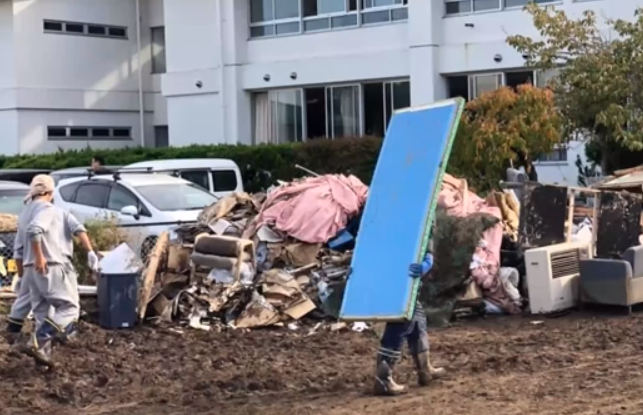How Business Can Revitalize a Community After Crisis
April 13, 2020
 Contributed by Michael Neidert. Ryota Saito is an entrepreneur and member of Entrepreneurs’ Organization in Japan. He shared his experiences persisting despite disaster in a recent EO webinar about rebuilding through business.
Contributed by Michael Neidert. Ryota Saito is an entrepreneur and member of Entrepreneurs’ Organization in Japan. He shared his experiences persisting despite disaster in a recent EO webinar about rebuilding through business.
When Ryota Saito left his home in Tokyo on 11 March 2011, he expected a typical day as a Microsoft employee.
Instead, he found himself at the epicenter of an earthquake and tsunami. The disaster left nearly 16,000 people dead and 2,500 missing.
While Saito avoided danger that day, he saw the devastating impact firsthand and recognized the experience as his call to service. From 2011 to 2013, he worked with Microsoft to distribute PCs to hard-hit areas. He also trained community members to utilize technology as the area rebuilt.
A Direct Avenue for Making a Difference
Eventually, his contributions felt empty. His eagerness subsided as he wondered what more he could do to make a difference. This time of reflection revealed entrepreneurship to be the most direct avenue for making a difference.
This time of reflection revealed entrepreneurship to be the most direct avenue for making a difference.
 In 2016, Saito and his family moved to the still-recovering region of Tohoku. Taking a chance on an agricultural area with few visitors, Saito planned to attract foreign tourists (and their funds), creating tours, collaborating with agricultural partners and eventually joining EO North Japan to expand his skills and network. Building his legacy as a socially-minded entrepreneur proved a winning combination and his company, VISIT Tohoku, expanded with a new office and satellite business in rural Taiwan.
In 2016, Saito and his family moved to the still-recovering region of Tohoku. Taking a chance on an agricultural area with few visitors, Saito planned to attract foreign tourists (and their funds), creating tours, collaborating with agricultural partners and eventually joining EO North Japan to expand his skills and network. Building his legacy as a socially-minded entrepreneur proved a winning combination and his company, VISIT Tohoku, expanded with a new office and satellite business in rural Taiwan.
However, disaster struck again in 2019.
A typhoon pummeled the company’s new office, leaving one meter of water in its wake. What might have spelled the end of a business for others barely fazed Saito, who drew strength from a community rebuilding once again.
“All we knew to do was to stand up once again,” Saito reflects.
Quickly, EO members from Osaka and Tokyo rushed to help. Meanwhile, Saito continued serving people. He organized free massages for senior community members. He helped with cleanup efforts. He established a childcare center to help families, an initiative that continues to operate, though unrelated to Saito’s core business.
What might have spelled the end of a business for others barely fazed Saito who drew strength from a community rebuilding once again.
From Crisis, Opportunity
Out of this crisis came a new business opportunity. Reflecting on the difficulty of cooking after the typhoon, Saito and his team created a Disaster Prevention Rice Ball, a product that created more demand for local agriculture and served as an emergency ration for future crises.
Five months after the typhoon and rebuilding of his business, COVID-19 is impacting people around the globe, including Saito. However, he draws confidence from his past experiences.
“I’m not really fazed by this. It gives us a chance to think about new things, give help to others or be helped by others.”
Rebuilding After Disaster
Here are six takeaways from Saito’s experience rebuilding after crises:
1. Serve communities and people.
A crisis will pass but how a business behaves during that time will be ingrained in the memories of employees, consumers and community members—for better or worse. It’s an opportunity to do the right thing, but it’s also a crucial moment to consider public perception.
The willingness of community members to help Saito and his business get back on track is a testament to how he behaves in a crisis.
“With passion, care and connection with others,” Saito says, “business will pick up and people will follow.”
2. Don’t ignore emotions during a crisis.
A crisis has financial impact, but there’s a human impact, too. In the midst of COVID-19, savvy brands are thinking about the emotions of their community and responding proactively with kindness and generosity, offering flexibility for employees or perks for customers.
After the typhoon, Saito’s recovery efforts addressed the emotions of his community. They played traditional Japanese drums to boost morale and provided childcare for community members, efforts that rebuilt a sense of normalcy and optimism.
3. Seek and accept help.
Entrepreneurs may prefer to help instead of being helped, however, a crisis is an ideal (and likely necessary) moment to ask for and accept help; sometimes accepting help is the only way to help others. As a bonus, it’s a chance to forge lifelong bonds and relationships.
Saito was only able to continue helping others after he accepted help from his community and EO members. “I cannot accomplish everything myself,” Saito notes. “When we are faced with difficulties, we should work with everyone.”
4. Think about your legacy, even in the face of adversity.
A crisis is never too turbulent to consider what it means for you and your long-term legacy. This is the time when mission statements and brand values are lived or ignored.
After the typhoon, Saito could have looked inward and worried only about his business, but this would have been counter to his values. He knew his legacy and success depended upon the success of his community.
5. Identify what will make you stronger after this crisis—and take action.
Whether there’s a marketing plan you’ve been putting off or a tough call that needs to be made, this is the time to estimate what business will look like when life returns to normal and take proactive steps to come out stronger.
As Saito’s business slows due to COVID-19, he’s using this time to find new partners and expand his network. “It may be a long dark period,” he concedes, “but dawn will come.”
6. Anticipate the next crisis.
Expecting the next crisis isn’t fatalistic or pessimistic, it’s realistic. Whether it’s an economic recession, industry shift, natural disaster or pandemic, every business will face future crises.
It’s never too soon to prepare or reflect on today’s lessons. Look at your blind spots, vulnerabilities and ask those “what-if” questions so you can thrive in a crisis—just like Saito.
Visit the #EOTogether platform often for the latest webinars and resources.